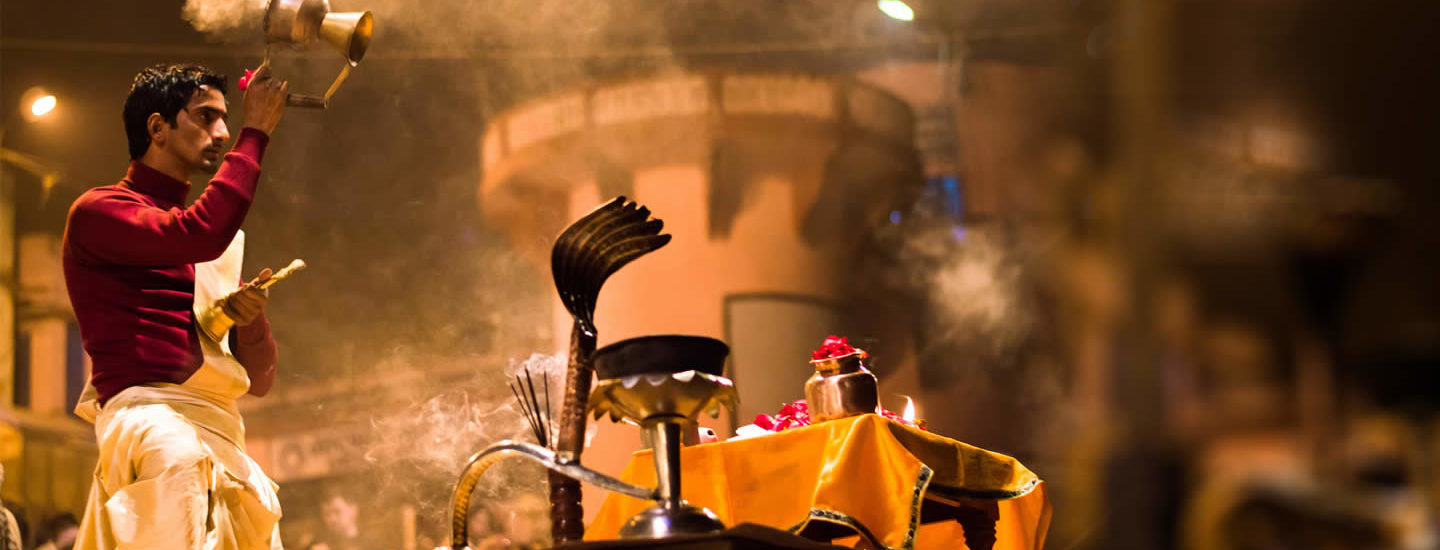Pujas & Festivals – Varanasi
The most important religious rituals at the Kashi Vishwanath temple are the five aartis that are performed during a day. Starting at 3 am in the morning when Lord Vishwanath is woken by the soft mellifluous playing of the shehnai from the naubat khana and then bathed and decorated to the chanting of mantras.
Eleven priests, called shastris bathe the lingam with Gangajal and then with a mix of bhang, honey, ghee and milk. Then the three stripes of the tripundraka are drawn with sandalwood paste and the lingam is garlanded with flowers. The many flamed aarti lamps are then waved before the deity with the blowing of conches, drums and bells are played as the air turns smoky with incense.
Puja Schedule at Kashi Vishwanath temple
DAILY AARTI PROGRAMME |
|
|---|---|
| 3 am | Mangala Aarati |
| 12 noon | Bhog Aarati |
| 7.30 pm | Saptarishi Aarti |
| 9 pm | Shringar Aarti |
| 11 pm | Shayan Aarti |
The Temple closes at 11 pm except on the night of Maha Shivaratri when it remains open all day and night.
OTHER RELIGIOUS RITUALS
There are a number of other religious rituals that are offered by the shastris.
Please check the details of the ritual and rates at the temple website: www.shrikashivishwanath.org
The other rituals at the temple are:
| Rudrabhishek | Mundan |
| Laghu Rudra | Akhand Deep |
| Maharudra | Vilvarchana |
| Dainik Bhog | Dainik Archana programme |
| Sanyasi Bhog (Mondays) | Abhishekh & Archana |
| Shravan Prasad (Mondays) & Shringar | Aarti & Shringar |
| Shringar | Free feeding |
| Poornima Shringar | Sarwa Puja |
| Milk offerings | Nitya Prasadam |
| Katha |
Festival
With so many temples dedicated to just about every god and goddess in the Hindu pantheon there is a festival being celebrated somewhere all the time. Below we are giving details of some of the important festivals of Varanasi.
Please remember that the dates of each festival will change from year to year as the Hindu calendar is a lunar one. Do check in an almanac like the panchang or on line at the temple website for the exact date.
For a detailed description and latest dates of these Hindu festivals you can also check the website and the Facebook page of Daiwik Hotels.
JANUARY TO MARCH
- Makar Sankranti – According to the solar calendar the sun moves from the Dhanu rashi to the Makar rashi on this day. The period of Uttarayan starts from this day when the sun begins its journey to the northern hemisphere.
- Basant Panchami – Celebrates the arrival of spring and also Saraswati the goddess of knowledge is worshipped on this day
- Maha Shivaratri – This is the great night of Shiva and the most important festival in Varanasi. Here they celebrate this as the night when Shiva married Parvati. A huge wedding procession called Shiva Baraat is taken out in the lanes to the beating of drums and shouts of “Jai Bhole Shankar!” People fast and pray for the day and night. It is also said that on this night Shiva takes the form of Nataraja, the Lord of Dance and dances the tandava,
- Rangbhari Ekadashi – Lord Vishwanath at the Kashi Vishwanath temple is given a special shringar or decoration.
- Holi – The festival of colours. This is a bacchanalia with people drinking intoxicants and throwing colours. Visitors are recommended to stay indoors.
APRIL TO JUNE
- Ganga Saptami – The Ganga River is worshipped on the day that the river descended to earth from heaven.
- Ganga Dussehra – The Ganga is garlanded on the day the river entered the plains. Giant marigold garlands are taken out in boats and strung across the waters and at night the river is full of lamps floating in leaf cups.
- Navaratri – the nine nights of the goddess when people fast and pray to the Devi and visit the temples of the goddess.
- Ramnavami – the birth of Lord Ram is celebrated with day and night recitals from Tulsidas’ Ramcharitmanas.
JULY TO SEPTEMBER
- Prayaschitta – Devotees perform this rite of atonement at the ghats.
- Ganesh Chaturthi – Ganesh, the elephant headed god of good fortune and wisdom is worshipped.
- Janamashtami – Celebrates the birth of Lord Krishna, the ninth avatar of Lord Vishnu with all night prayers.
OCTOBER TO DECEMBER
- Pitripaksha – Pilgrims arrive from across the country to worship their ancestors at the ghats with the ritual of shraadh.
- Durga Puja – The Bengalis of the city worship goddess Durga with beautiful earthen images that are later taken out by boat and immersed in the river.
- Dussehra – a unique celebration at Ramnagar across the river. The folk theatre of the Ram Leela is performed at specially designed sets and stages all across the fort. The play is based on the Ramcharitmanas. The Ram Leela goes on for nine nights ending on Dusssehra.
- Diwali – The festival of light when the city and the ghats glitter in the light of earthen lamps.
- Annakuta – a harvest festival celebrated at the Annapurna Bhavani temple near Kashi Vishwanath temple. Huge piles of cereals, grains, vegetables, fruits and sweets are collected in the courtyard and then given away as prasad.
- Kartik Purnima – the full moon night when a tall pillar, the deepajara sthambha is lit on Panchganga ghat. The pillar holds one thousand lamps.
- Dev Diwali – A diwali for the gods celebrated at the ghats with lamps.
- Nag Nathaiya – A 20 day celebration of the life of Lord Krishna at Tulsi Ghat with pageants and theatre
A Lunar Calendar Of Varanasi |
|
|---|---|
| Vaisakha | Akshaya Tritiya / Trilochana Darsha / decoration of Manikarnika Kund / Ganga Saptami |
| Jyeshtha | Shitala Ashtami / Ganga Dussehra |
| Ashadh | Rath Yatra / Vishnu Shayani Ekadashi |
| Shravan | Nava Gauri / Naga Panchami |
| Bhadrapada | Kajali Tij / Ganesh Chaturthi / Janamashtami / Haritalika Teej / Lolarka Sashthi |
| Ashvin | Pitri Paksha / Navaratra / Durga Puja / Vijaya Dashami & Dussehra |
| Kartik | Dhanteras / Hanuman Jayanti / Diwali / Annakuta / Bhima Dwitiya / Prabodhini / Vaikunth Chaturdashi / Kartik Purnima |
| Agrahayana | Bhairava Ashtami |
| Paush | Paush Purnima / Makar Sankranti |
| Magh | Mauni Amavasya / Basant Panchami |
| Phalgun | Maha Shivaratri / Rangbhari Ekadashi |
| Chaitra | Navaratra / Ram Navami / Holi |
Yatras – Panchkrosi & Panch tirthi
Devout pilgrims undertake the journey called yatra in Varanasi and the two most popular are the Panchkroshi and Panchtirthi yatras. During a yatra the pilgrim walks barefoot, in silence and eats vegetarian food once a day.
The Panchkroshi Yatra, a walk for twenty five kroshas is the most arduous. It is a five day, 80 kilometre trek that takes the pilgrim to the most sacred ghats, temples and also out into the outskirts of the city visiting temples there. This yatra covers the traditional Kashi Kshetra and is undertaken in large groups and under the guidance of experienced shastris.
The Panchtirthi Yatra is more popular among pilgrims. Starting from Assi Ghat the yatris walk to five sacred ghats where they bathe and perform puja. Usually done in one day they visit Assi, Dasaswamedha, Adi Keshava, Panchganga and Manikarnika ghats. Then they enter the Kashi Vishwanath temple to perform puja and watch an aarti. Their journey ends at the Sakshi Vinayak temple nearby where they pray to Ganesh to bear witness that they have completed the yatra.
A shorter version of the Panchtirthi yatra is called Tritirthi Yatra and pilgrims visit three ghats of Dasaswamedha, Manikarnika and Panchganga.


